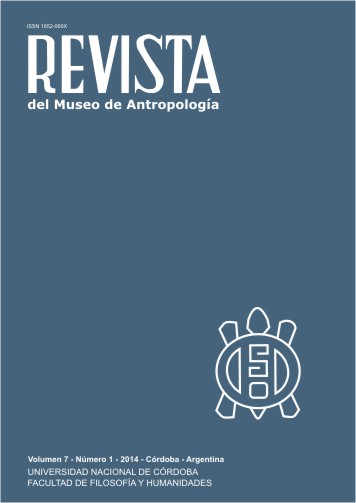An ethnographic approach to Belgrano fans: violence, identity and power in “Los Piratas”
DOI:
https://doi.org/10.31048/1852.4826.v7.n2.9186Keywords:
violence, identity, popular culture, football fans, “aguante”Abstract
In this paper we will exhibit some questions and reflections that emerge from our final work of the Bachelor’s degree in Sociology of the UNVM, which was to investigate the place occupying the violence in the configuration of the logical identity of the popular sectors taking as a case the the group of football fans of the Club Atlético Belgrano de Córdoba. The paper is divided into two parts that are intimately related: on the one hand we will propose a “thick description” on the complex inner universe of the fans of Belgrano. We will explain its sociological most relevant characteristics as well as the power relations that structure its current organization and operation logic. And in a second part we will deepen in the native notion of “aguante” as fundamental resource to understand the logical identity that the fans of Belgrano constructed from violent practices. From the “sociological imagination”, this article proposes to think from the existing intersections between the macro-structural processes and the specificities of the case, only from this area will outline a comprehensive explanation of a phenomenon as complex and elusive.Downloads
References
Alabarces, P (2004): Crónicas del aguante. Fútbol, violencia y política, Capital Intelectual, Buenos Aires.
Alabarces, P. y Rodríguez, M. G. (comps.) (2008): Resistencias y mediaciones: estudios sobre cultura popular, Paidós, Buenos Aires.
Alabarces, P.; Garriga Zucal, J. y Moreira, M. V. (2008): “El aguante y las hinchadas argentinas: una relación violenta” en Horizontes Antropológicos, año 14, N° 30, p. 113- 136, Porto Alegre.
Cabrera, N. (2012a): “Violencia e identidad en una hinchada de fútbol: sólo para entendidos”. I.A.P. Ciencias Sociales, UNVM, Argentina, 210 pág. Tesis de licenciatura en Sociología, Inédita.
Dodaro, C. (2005): “Aguantar no es puro chamuyo. Estudio de las transformaciones en el concepto nativo” en Alabarces, P. et al., Hinchadas, Prometeo, Buenos Aires.
Elias, N. y Scotson, J. (2000): Os Estabelecidos e os Outsiders. Sociologia das relações de poder a partir de uma pequena comunidade. Jorge Zahar Editor, Río de Janeiro.
Garriga Zucal, J. (2010): Nosotros nos peleamos. Violencia e identidad en una hinchada de fútbol, Prometeo, Buenos Aires.
Garriga Zucal, J. y Noel, G. (2010): “Notas para una definición antropológica de la violencia: un debate en curso” en Publicar en Antropología y Ciencias Sociales, Año VIII, N°IX, Buenos Aires.
Giddens, A. (2001): Las nuevas reglas del método sociológico: crítica positiva de las sociologías comprensivas, Amorrortu, Buenos Aires.
Gil, G. (2007): Hinchas en tránsito: violencia, memoria e identidad en una hinchada de un club del interior, EUDEM, Mar del Plata.
Grimson, A. (2011): Los límites de la cultura, Siglo Veintiuno Editores, Buenos Aires.
Jelin, E. (2002): Los trabajos de la memoria, Siglo XXI, Buenos Aires.
Míguez, D. (2008): Delito y cultura. Los códigos de la ilegalidad en la juventud marginal urbana, Editorial Biblos, Buenos Aires.
Míguez, D. y Semán, P. (2006): Entre santos, cumbias y piquetes. Las culturas populares en la Argentina reciente, Biblos, Buenos Aires.
Moreira, V. M. (2005): “Trofeos de guerra y hombres de honor” en Alabarces, P. et al., Hinchadas, Prometeo, Buenos Aires. Salvia, A. y Quartulli, D. (2009): “La movilidad y la estratificación socio-ocupacional en la Argentina. Un análisis de las desigualdades de origen” ponencia publicada en Bialakowsky, A. y Lago Martínez, S. (comps.) Memorias XXVII Congreso ALAS 2009, UBA, Buenos Aires
Weber, M. (1994): Economía y sociedad: Esbozo de sociología comprensiva, Fondo de Cultura Económica, México.
Downloads
Published
Issue
Section
License
Those authors who have publications with this Journalaccept the following terms:
a. Authors will retain their copyrights and guarantee the journal the right of first publication of their work, which will be simultaneously subject to the Creative Commons Attribution License (Licencia de reconocimiento de Creative Commons) that allows third parties to share the work as long as its author and his first publication in this journal.
b. Authors may adopt other non-exclusive licensing agreements for the distribution of the version of the published work (eg, deposit it in an institutional electronic file or publish it in a monographic volume) provided that the initial publication in this journal is indicated.
c. Authors are allowed and recommended to disseminate their work on the Internet (eg in institutional telematic archives or on their website) before and during the submission process, which can lead to interesting exchanges and increase citations of the published work. (See The Effect of Open Access - El efecto del acceso abierto)












